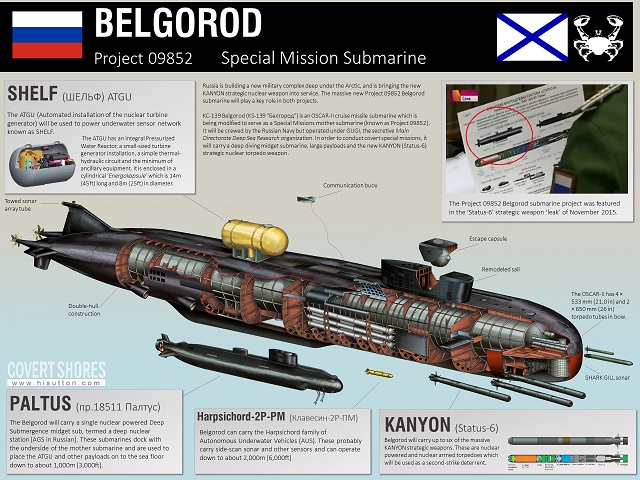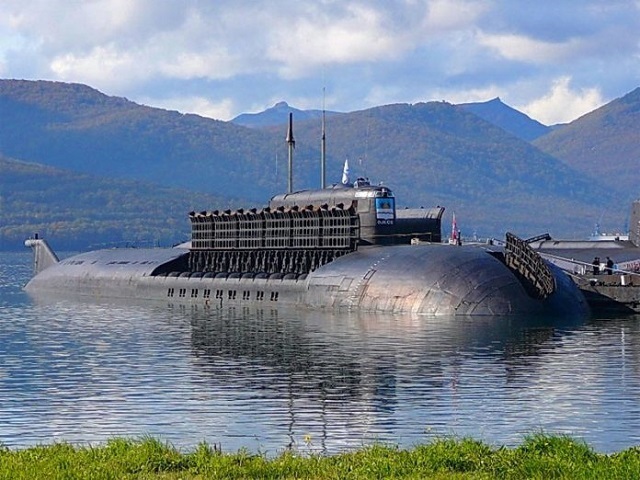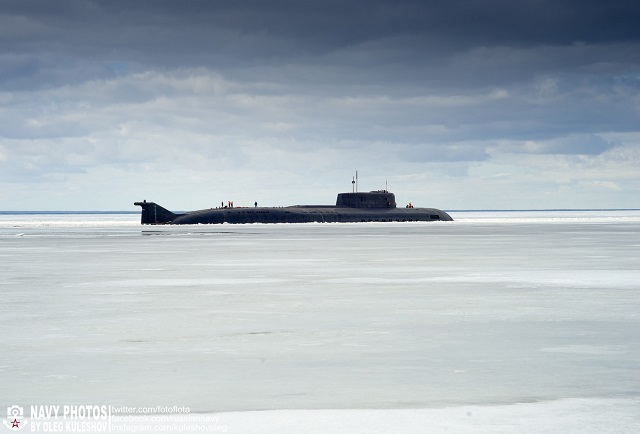|
|
|||
| a | |||
|
Naval Forces News - Project 09852 Belgorod
|
|||
|
|
|||
|
Russian Navy to commission Project 09852 KS-139 Belgorod special mission submarine in 2018
|
|||
|
The Project 09852 (NATO reporting name: Oscar II-class) Belgorod nuclear-powered research submarine will be received by the Russian Navy in 2018. The advanced ship will carry deep-water unmanned submersibles and bathyscaphes and special scientific instruments. In expert opinion, the sub can be used both for military deep-water missions and for Arctic offshore prospecting and mining, according to the Izvestia daily.
|
|||
|
|
|||
 Artist impression of Project 09852 Belgorod. Image via covert shores. Artist impression of Project 09852 Belgorod. Image via covert shores. |
|||
|
|
|||
|
The Northern Fleet HQ has told Izvestia that the upgrade of the equipment aboard the Belgorod is still in progress to tailor the ship to new missions. The work is due for completion next year, with the Navy to receive the boat then. For now, the Belgorod is on the slipway of the world’s largest Shop 55 of the Sevmash Shipyard.
The Belgorod is the derivative of an unfinished Project 949A Antei-class (Oscar II-class) nuclear-powered cruise missile attack submarine. The latter class was developed by the Soviet Union in response to the deployment of US Navy aircraft carrier battle groups throughout the ocean. Sevmash laid down the Belgorod in 1992, but the construction of the submarine, which was 76% complete, was put on the back burner in 2006. However, the Navy again took interest in the unfinished submarine, albeit in a role different to her aircraft carrier killer purpose. The top brass decided to convert the ship into a carrier of deep-water manned and unmanned submersibles. The sub is supposed to be equipped with the plethora of special and diving equipment and pressure equalization chambers for access to deep-water submersibles. One of the latter is the Bester. The Belgorod also will carry the Magma geophysical complex for offshore geological exploration in the Arctic. The Magma will slash the cost of the research in inaccessible areas fourfold. Research will be feasible irrespective of weather and ice conditions. "The Belgorod may well be called a multipurpose submarine," expert Dmitry Kornev tells Izvestia. "The boat can haul deep-water submersibles, bathyscaphs and remote-controlled systems. She herself will be able to operate down on the seabed too. Therefore, the Belgorod can be used for both military and peaceful purposes. For instance, the submarine will lay underwater cables or set up the Garmoniya system. She also will assist in mineral exploration and production on the Arctic shelf plate." |
|
|
|||
 Russian Navy submarine Omsk (K-186), a Project 949A SSGN (NATO designation: Oscar II), with all missile hatches opened. Picture via airbase.ru Russian Navy submarine Omsk (K-186), a Project 949A SSGN (NATO designation: Oscar II), with all missile hatches opened. Picture via airbase.ru |
|||
|
|
|||
|
There is no direct analog to the Belgorod in the world, according to experts. The US Defense Advanced Research Projects Agency (DARPA), in conjunction with private firms, is running the Poseidon program that cost it about $70 billion a year. The Poseidon is an underwater analog of the GPS system - a system of deep-water relay stations, while Russia is developing a carrier of such equipment, which is capable of not only intelligence, surveillance and relevant equipment emplacement, but servicing the equipment on the seabed as well.
The Project 09852 nuclear-powered research submarine will be the largest in the Russian Navy’s submarine fleet, larger than the Project 941 (Typhoon-class) SSBN listed in the Guinness Book of Records. At present, the Belgorod is on the slipway of Sevmash. Her central section has been redesigned and her missile compartment has been replaced with a new one measuring almost 30 m long. It will house the special equipment and is equipped with pressure equalization chambers for submariners to access the submersibles and for divers to exit the ship. The compartment replacement extended the nuclear-powered submarine from 154 m to 184 m - 11 m longer than the world’s longest Project 941 boat. |
|||
|
|
|||
 Project 949A Antey-class (NATO reporting name: Oscar II-class) nuclear-powered submarine Orel (K-266) sailing out of Zvyozdochka Shipyard on April 6 2017. Picture by Oleg Kuleshov Project 949A Antey-class (NATO reporting name: Oscar II-class) nuclear-powered submarine Orel (K-266) sailing out of Zvyozdochka Shipyard on April 6 2017. Picture by Oleg Kuleshov |
|||
|
|
|||
|
Academy of Military Sciences Professor Vadim Kozyulin has told TASS that the Belgorod will be not only the largest submarine in the Russian Navy’s inventory but the service’s unique one.
"Presumably, the Belgorod will carry the AS-31 Losharik self-contained deep-water station," the expert said. "She will haul and emplace on the seabed self-contained nuclear modules designed to recharge unmanned submersibles. The submarine will deploy a global underwater surveillance system the military has been creating on the Arctic seabed." Prior to the Belgorod’s advent, the Project 941 SSBNs were a unique class of weapons system in the world, each displacing almost 50,000 tons, and having a length of 172.8 m and a beam of 23 m. Under the light hull, there are several pressure hulls housing the action stations, crew accommodations, a sauna, a swimming pool, a gym and, lo and behold, a smoking room - something no other submarine in the world can boast. There are 20 RSM-52 (SS-NX-20 Sturgeon) submarine-launched ballistic missile silos between the two main hulls. Each of the SLBMs packs 10 individually targeted nuclear re-entry vehicles. The bow accommodates six torpedo tubes fit for launching torpedoes and underwater high-speed missiles and for deploying sea mines. Now, only one of the six Project 941 SSBNs - the TK-208 Dmitry Donskoi - is in service. The submarine is used for testing naval weapons and equipment of new types. She conducted the first launches of the advanced Bulava (SS-NX-32) SLBM, according to the Izvestia daily. © Copyright 2017 TASS. All rights reserved. This material may not be published, broadcast, rewritten or redistributed. |
|||










